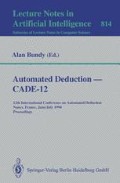Abstract
We present modifications of model elimination which do not necessitate the use of contrapositives. These restart model elimination calculi are proven sound and complete. The corresponding proof procedures are evaluated by a number of runtime experiments and they are compared to other well known provers. Finally we relate our results to other calculi, namely the connection method, modified problem reduction format and Near-Horn Prolog.
Preview
Unable to display preview. Download preview PDF.
References
R. Anderson and W. Bledsoe. A linear format for resolution with merging and a new technique for establishing completeness. J. of the ACM, 17:525–534, 1970.
Owen L. Astrachan and Mark E. Stickel. Caching and Lemmaizing in Model Elimination Theorem Provers. In D. Kapur, editor, Proceedings of the 11th International Conference on Automated Deduction (CADE-11), pages 224–238. Springer-Verlag, June 1992. LNAI 607.
P. Baumgartner. A Model Elimination Calculus with Built-in Theories. In H.-J. Ohlbach, editor, Proceedings of the 16-th German AI-Conference (GWAI-92), pages 30–42. Springer, 1992. LNAI 671.
P. Baumgartner and U. Furbach. Consolution as a Framework for Comparing Calculi. Journal of Symbolic Computation, 16(5), 1993.
P. Baumgartner and U. Furbach. PROTEIN: A PROver with a Theory Extension Interface. In 12th International Conference on Automated Deduction. Springer, 1994. (in this volume).
W. Bibel. Automated Theorem Proving. Vieweg, 2nd edition, 1987.
E. Eder. Consolution and its Relation with Resolution. In Proc. IJCAI '91, 1991.
E. Eder. Relative Complexities of First Order Languages. Vieweg, 1992.
M. Fitting. First-Order Logic and Automated Theorem Proving. Texts and Monographs in Computer Science. Springer, 1990.
D. M. Gabbay. N-Prolog: An extension of Prolog with hypothetical implication II. logical foundations, and negation as failure. The Journal of Logic Programming, 2(4):251–284, December 1985.
J. Gallier. Logic for Computer Science: Foundations of Automatic Theorem Proving. Wiley, 1987.
R. Letz, K. Mayr, and C. Goller. Controlled Integrations of the Cut Rule into Connection Tableau Calculi. Journal of Automated Reasoning (to appear 1994), 1993.
D. Loveland. Mechanical Theorem Proving by Model Elimination. JACM, 15(2), 1968.
D. Loveland. Near-Horn Prolog and Beyond. Journal of Automated Reasoning, 7:1–26, 1991.
D.W. Loveland and D.W. Reed. A near-horn prolog for compilation. Technical Report CS-1989-14, Duke University, 1989.
R. Letz,J. Schumann, S. Bayerl, and W. Bibel. SETHEO: A High-Performace Theorem Prover. Journal of Automated Reasoning, 8(2), 1992.
L. M. Pereira, L. Caires, and J. Alferes. SLWV — A Theorem Prover for Logic Programming. AI Centre, Uninova, Portugal, July 1991.
D. Plaisted. Non-Horn Clause Logic Programming Without Contrapositives. Journal of Automated Reasoning, 4:287–325, 1988.
D. Plaisted. A Sequent-Style Model Elimination Strategy and a Positive Refinement. Journal of Automated Reasoning, 4(6):389–402, 1990.
D. W. Reed and D. W. Loveland. A Comparison of Three Prolog Extensions. Journal of Logic Programming, 12:25–50, 1992.
G. Sutcliffe, C. Suttner, and T. Yemenis. The TPTP problem library. In Proc. CADE-12. Springer, 1994.
M. Stickel. A Prolog Technology Theorem Prover: Implementation by an Extended Prolog Compiler. Journal of Automated Reasoning, 4:353–380, 1988.
Author information
Authors and Affiliations
Editor information
Rights and permissions
Copyright information
© 1994 Springer-Verlag Berlin Heidelberg
About this paper
Cite this paper
Baumgartner, P., Furbach, U. (1994). Model elimination without contrapositives. In: Bundy, A. (eds) Automated Deduction — CADE-12. CADE 1994. Lecture Notes in Computer Science, vol 814. Springer, Berlin, Heidelberg. https://doi.org/10.1007/3-540-58156-1_7
Download citation
DOI: https://doi.org/10.1007/3-540-58156-1_7
Published:
Publisher Name: Springer, Berlin, Heidelberg
Print ISBN: 978-3-540-58156-7
Online ISBN: 978-3-540-48467-7
eBook Packages: Springer Book Archive

